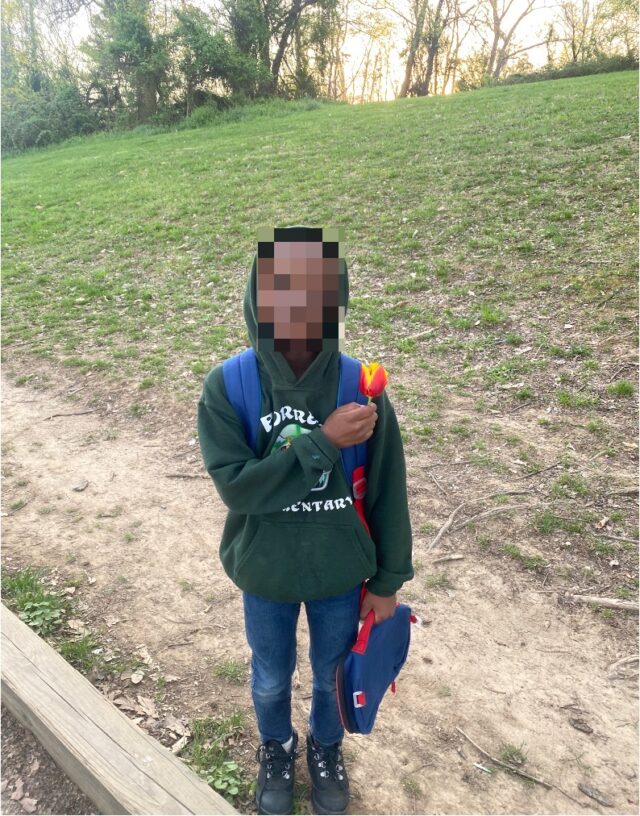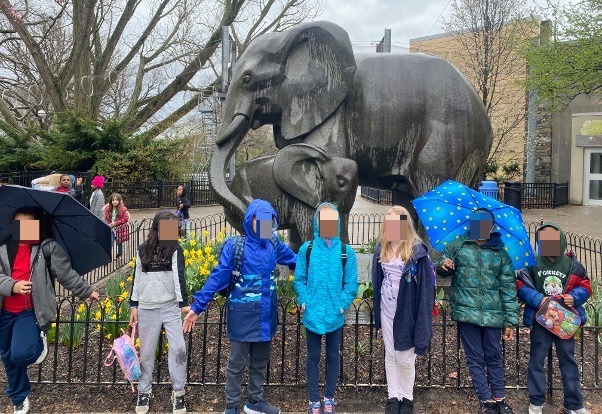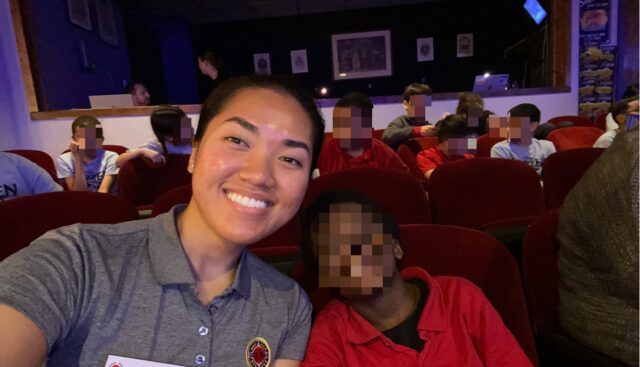Creating and Maintaining Positive Mentor-Mentee Relationships
Why I Serve and What My Day Looks Like
When my alarm goes off at 5:45 each morning, I think of why I serve. I think to myself, the students. Specifically, the third-grade students of 425 at Forrest Elementary. As a class, we have experienced many unexpected challenges throughout the year and have managed to persevere through each challenge together. This group of students are the reason I rip off the covers and get ready for the day without a second thought.
I arrive at Forrest Elementary every morning at 7:00 with the readiness to serve and be there for my students in the best ways I know. I spend most of the time in school working with them directly in the classroom, known as Tier 1 support. During this time, students may need answers to questions, words of reassurance, or support with classroom tasks. When students need a break outside of the classroom, I find that Tier 2 support—having one-on-one time with a student to have a snack, color, or talk about what’s on their mind—can be beneficial for their focus when they return to the room.
Though some days are more challenging than others, it is incredibly rewarding to see the progress of students’ social-emotional learning (SEL) throughout the days we spend together.

A student, who I often see on my walk to school, picking me my favorite flower (tulip) on his way in.
Showing Up with Intention
I believe that showing up with the intention of being present, during Tier 1 support, is vital to build trust with the students we see every day. As a Student Success Coach, it is critical to stay present and actively engage with our students inside the classroom as much as possible. Some examples of how I stay present and engaged are walking around the classroom, giving positive feedback on students’ work, kneeling to desk level to answer questions, and attending to any social-emotional needs that students have. Social-emotional situations can range from conflicts with peers, to thoughts they have about an internal or external issue, or to needing one-on-one reassurance.

Treading through a rainy (but fabulous) day at the Philadelphia Zoo with students.
D.H., at the beginning of the year, was shy and would occasionally ask for help during in-class instruction. As the school year progressed, D.H. grew to be a student who confides in me often. D.H. oftentimes deals with external conflicts with peers. As a result, she is expressive when needing more support by asking, “Can I talk to you?” When this happens, I find the space to talk to her after the lesson concludes. We walk out into the open pod to sit down and have a conversation about what’s on her mind. Depending on how she is feeling by the end of the conversation, I ask her if she’s thinking about anything else and if she needs a hug.
The act of showing up can look different for everyone, but how we do things is just as important as why we do things. My why are the students. My how is in the ways I am present and engaged with students each day. By understanding the intentionality behind my actions and what is powering me through even the most challenging days during the school year, I fuel my fire by being there for our students with much gratitude, presence, and care. Some students need words of reassurance, while others need a listening ear or a hug. Whatever it may be, being able to show up with intention takes care and patience. But seeing a student walk back into class with less weight on their shoulders makes the challenging moments worth it.
“The act of showing up can look different for everyone, but how we do things is just as important as why we do things. My why are the students. My how is in the ways I am present and engaged with students each day.”
Importance of Establishing Boundaries
While it is important to keep a level of consistency with students in how we show up, it is just as important to remind students of our own boundaries. I define “boundaries” as social, emotional, and physical limits that I can put in place to create a stronger foundation in my relationships.
As a natural people pleaser, I initially felt inclined to say “yes” to every student request at the beginning of the school year. However, when I have 30 students I work with each day in the classroom—not to mention many more whom I see in the hallways—I quickly realized that saying “yes” to everything and everyone would be the quickest way to burn myself out before the day ends. I learned it is okay to pause and consider if the request is within my capacity.

Enjoying the Frozen play at the Walnut Street Theatre with students.
When students ask me for things I cannot give now, I communicate with them in a way they can understand. For example, I have a student, I.R., who tends to ask me for a break when we are in the middle of an important part of a lesson. When he does this, I let him know that this lesson is important to the day’s assignment and that I am more than happy to take him for a snack and coloring break afterwards.
This boundary is set in place for I.R. to understand that while he cannot get what he wants at the instant, it does not mean that he will not get what he wants at all. It allows him to focus on the lesson and be patient with me, and to understand that he will be rewarded for working hard and staying on task. I do my best to fulfill my end of the agreement so the trust in the student relationship continues to build.
Boundaries can be challenging to set in place. But when they are, it opens the door for trust, understanding, and mutual respect.
Putting Relationship-Building to Practice
In the beginning of the year, R.T. was a student who did not enjoy the early mornings and struggled with class assignments and socializing with his classmates. I found that he was not receiving a full night’s sleep and skipping breakfast. R.T. would often run out of the classroom and resist support from myself and his counselors. It was challenging to gain his trust, but no matter what happened, I showed up the next day with as much care and patience as possible.
Going forward, I checked in on R.T. throughout the day and guided him through assignments. Showing up each day in class and being present in mentoring sessions, I developed a deeper understanding of what works for him. Now, R.T. regularly communicates with me when he needs a break, opens up to me about what is on his mind, is improving in overall class participation, and is socializing more with his peers.
My “Why” and What’s Next After City Year
As an AmeriCorps member, I appreciate the long-lasting impact I can have on the spaces I enter just by showing up with the intention to be authentic and flexible with challenges. It is vital to stay consistent in patience, empathy, and communication with students to gain their trust and build a solid foundation for positive mentoring relationships. It is also essential to keep emotional, mental, and physical boundaries in my relationships with students, or else I find myself with an empty cup before the day ends. I can be there for those around me while also being able to say “no” and prioritize my own well-being.
There is no doubt in my mind that I want to fulfill a role that supports and guides young people in realizing their full potential. The relationships I have cultivated with students like D.H., I.R., and R.T. is just one of many that have encouraged me to continue working with children. Following the completion of my service with City Year, I will be attending Arcadia University to pursue my Master’s in Counseling with a dual concentration in Child/Family Therapy and Trauma in hopes of becoming a Licensed Professional Counselor in my Philadelphia community.
So now, I ask you to reflect: How can you show up in spaces with authenticity while still being engaged? What are some boundaries that you have placed in your personal life that have aided in your overall relationship with the people around you? What is your “why”? What is your “how”? Asking yourself these questions can help you reflect on your purpose and what motivates you.
Are you considering a year of service, or do you know someone who is? City Year Philly is currently hiring full-time tutors and mentors for the 2023-2024 school year. Click below to start your journey.
Related stories
Student Success Coach Riya Sembhi (pictured front row, right, with her Sullivan Elementary team) shares her experiences serving a gap...
Read more about My Gap Year with City Year PhiladelphiaLeft: Hanna during her time serving as a City Year Philadelphia AmeriCorps member, 2019-2020. Right: Hanna in her current role...
Read more about Alumni Spotlight: Hanna Kim (‘20), Community Schools Volunteer Coordinator, City of PhiladelphiaPhiladelphia City Council President Kenyatta Johnson (pictured center, gray suit) is joined by leaders of local youth-serving organizations—including CYP Executive...
Read more about Spotlight on Kenyatta Johnson, City Year Philly’s 2024 Idealist of the YearDid you know that many alumni of Historically Black Colleges and Universities, known as HBCUs, apply to serve with City...
Read more about Leadership and community: reflections of an HBCU alum














